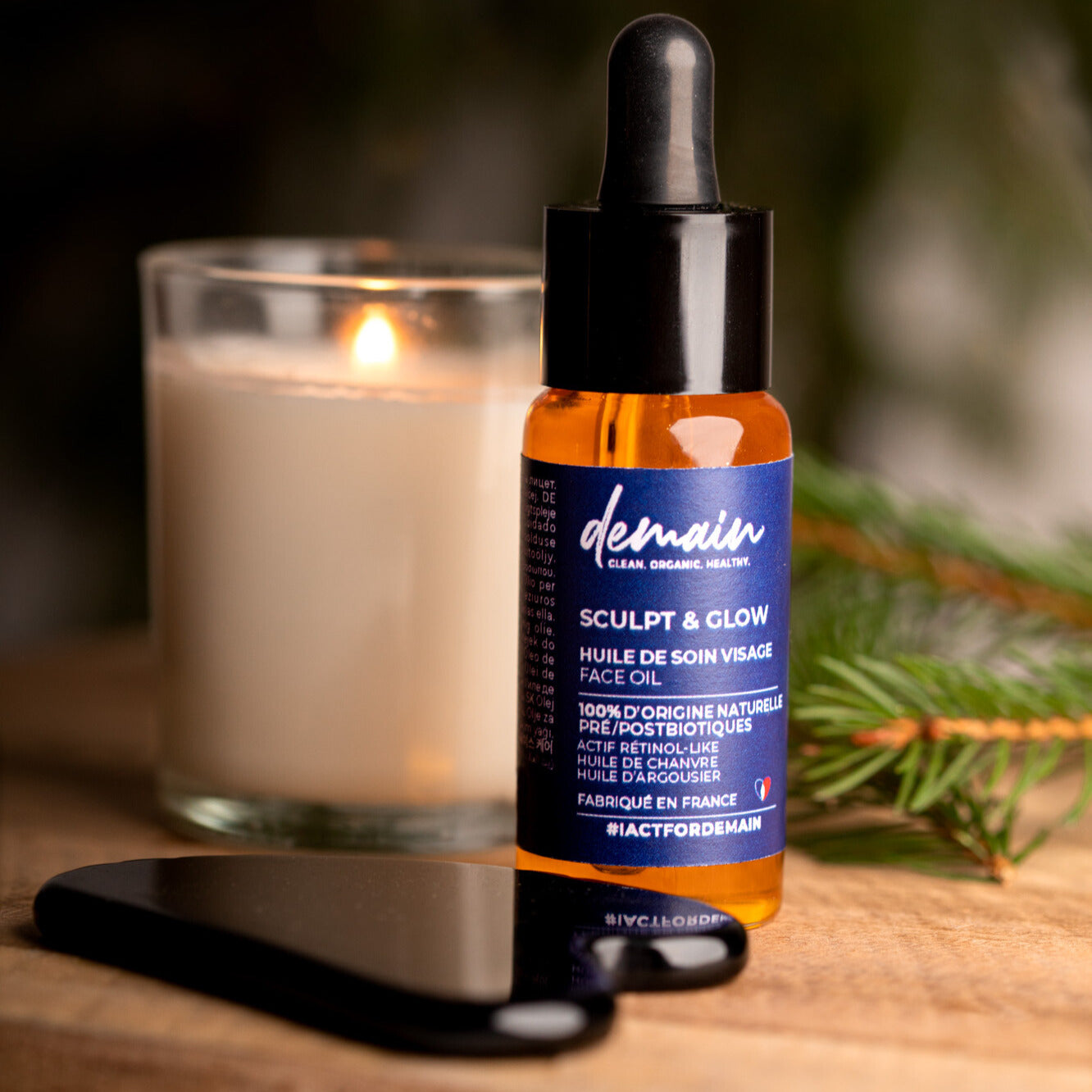The sun, a source of vitamin D and well-being, has another darker face. Excessive exposure can cause skin damage, accelerate skin aging and even cause diseases. Discover the effects of the sun on your skin, how it damages and how to repair burned skin. Protect your face, your health is at stake.
Understanding the effects of the sun on the skin
The sun emits radiation, including ultraviolet (UV) rays , which have a direct impact on the skin. UVA rays, mainly responsible for tanning, penetrate deep into the skin and can damage cells, thus promoting skin aging and the development of skin cancers. UVB rays, which are less numerous but more energetic, cause sunburn and also contribute to the development of skin cancers.
- Tanning : Tanning is the body's defense reaction to UV rays. It results from the production of melanin, a protective pigment, by melanocytes.
- Sunburn : Sunburn is an inflammation of the skin caused by overexposure to UVB rays. It results in redness and a burning sensation.
- Hyperpigmentation : Sun exposure can cause dark spots, also called solar lentigines. These are caused by excessive melanin production.
- Skin cancers : Repeated and intense exposure to the sun is the main risk factor for skin cancers. These include carcinomas and melanomas, the latter being the most dangerous.
The skin has defense mechanisms against these attacks, such as the production of melanin or the thickening of the epidermis. However, these protections are often insufficient, hence the importance of adopting preventive behaviors.
The harmful effects of the sun: injuries and diseases
Prolonged exposure to the sun can cause various types of injuries and diseases. Sunburn , a painful redness caused by UV rays, is the primary example. The appearance of brown spots , freckles , and hyperpigmentation are also signs of skin damage. Some disorders, such as solar urticaria and polymorphic light eruption , are characterized by itching in areas exposed to the sun.
Even more serious, exposure to the sun can cause actinic keratosis , a precancerous lesion that can eventually lead to skin cancers such as carcinomas and melanoma . It is therefore crucial to limit your exposure and adopt preventive behaviors.
Skin aging caused by the sun
Wrinkles: direct consequences of the sun
Wrinkles , the fine lines or grooves that mark the skin, are often associated with aging. However, they are also a direct result of excessive exposure to the sun. In fact, the sun's ultraviolet (UV) rays destroy the skin's collagen and elastic fibers, key elements of its structure and elasticity.
- When these components are damaged, the skin becomes sagging and thickened, worsening furrows and wrinkles.
- Brown spots may also form, and small areas of depigmentation appear.
- It is estimated that the sun is the cause of 80% of skin wrinkles.
It should be noted that even at a young age, the sun can begin to affect the youthfulness of our skin. At age 30, the first wrinkles can appear under the effect of the sun. It is therefore important to supplement with collagen, from the age of 25 to limit the arrival of signs of aging. To do this, opt for collagen and hyaluronic acid, Age With Grace .
How does the sun accelerate skin aging?
The sun accelerates skin aging through two main mechanisms. First, the sun's UV rays cause the excessive production of free radicals . These unstable molecules cause oxidative damage, breaking down structural proteins in the skin such as collagen and elastin. This process, known as oxidative stress , leads to a loss of elasticity and the appearance of wrinkles.
Second, UV rays can directly damage the DNA of skin cells. Unrepaired DNA damage can lead to changes in the structure of the skin, promoting the appearance of signs of premature aging such as wrinkles and pigment spots.
In short, excessive sun exposure disrupts the balance and regeneration of the skin, leading to premature aging.
Photo-aging: explanations and prevention
Photoaging , or photoaging, is a type of skin aging caused by prolonged exposure to the sun's UV rays. This process results in visible changes to the skin, such as the appearance of wrinkles, pigment spots, and loss of elasticity.
To prevent photoaging, a number of measures can be taken:
- Use a broad-spectrum sunscreen that provides protection against both UVA and UVB rays. Sunscreen should be reapplied every two hours and after swimming.
- Wear protective clothing, such as a wide-brimmed hat and sunglasses, when exposed to the sun.
- Avoid the sun during the hottest hours of the day, usually between 10 a.m. and 4 p.m.
- Eat a diet rich in antioxidants, which can help neutralize free radicals generated by sun exposure.
- Perform a regular skin self-examination to detect any suspicious changes.
These measures can help minimize sun damage to the skin and prevent photoaging. However, it is important to consult a dermatologist if you have any concerns or questions.
The sun and the face: a complex relationship
Specific damage to the face
Sun exposure particularly affects the face, as this area is often uncovered and therefore more vulnerable. Specific damage is manifested by accentuated wrinkles , more marked pigmentation spots , and even acne problems .
Wrinkles are caused by the breakdown of collagen and elastin fibers, caused by UV rays. The most affected areas of the face are usually the forehead, the eye area and the mouth.
Sun spots or pigmentation spots, also known as solar lentigines, are brown marks that appear mainly on areas exposed to the sun. They are more common in people with fair skin and with age.
Acne can also be influenced by sun exposure. Although the sun can temporarily dry out inflammatory lesions and improve the appearance of acne, the effect is often short-lived and can lead to worsening acne in the long term.
It is therefore essential to protect your face from the sun to prevent these specific damages. Protections can include regularly applying a broad-spectrum sunscreen, wearing a hat and sunglasses, and limiting direct sun exposure, especially during the hottest hours of the day.
UV Face Protection: Effective Methods
To effectively protect your face from UV rays, several methods can be adopted:
- Using cosmetics with sun protection : Many makeup and skin care products now include sun protection. Be sure to choose ones that offer broad-spectrum protection.
- Wear a wide-brimmed hat : This helps create shade on the face, reducing direct exposure to UV rays.
- Applying sunscreen : Choose a high protection factor (SPF 30 or higher) and remember to reapply it every two hours.
- Limit exposure during peak hours : Avoid the sun between 10am and 4pm, when UV rays are strongest.
- Consume foods rich in antioxidants : These nutrients help protect the skin against damage caused by free radicals produced by UV rays.
- Regular skin hydration : well-hydrated skin is more resistant to external aggressions, including UV rays.
The key to good protection lies in combining these different methods. Find all our tips for tanning quickly and safely on our blog.
Repairing facial skin after overexposure to the sun
After overexposure to the sun, the face requires specific care to regenerate. UV rays can dry out the skin, so it is imperative to rehydrate it. To do this, you can use after-sun creams that moisturize, soothe and repair the epidermis.
Some after-sun creams contain active ingredients , such as hyaluronic acid, which promote skin repair. These products are particularly effective in soothing the skin after overexposure to the sun and speeding up its regeneration.
It is also advisable to:
- Drink plenty of water to help replenish lost hydration.
- Use regenerating and calming products .
- Avoid further exposure to the sun to avoid further damage.
These measures can help reduce the damaging effects of the sun and promote repair of facial skin.
The benefits of the sun on the skin
Vitamin D synthesis and other benefits
Sunlight promotes the body's synthesis of vitamin D , a process that takes place in the upper layers of the epidermis. This vitamin plays a crucial role in regulating the immune system and bone health. In addition, moderate exposure to sunlight can also help improve our mood.
- It is recommended to expose your arms and face to the sun for 10 to 15 minutes a day to promote the production of vitamin D.
- UV-B rays, contained in sunlight, are essential for the synthesis of this vitamin. These same rays are also responsible for tanning the skin.
- 7-dehydrocholesterol, a derivative of cholesterol found in our skin, is transformed by the sun's UV rays into vitamin D.
However, it is important to note that sun exposure should be moderate and protected to avoid skin damage.
Summary: Advantages and disadvantages of sun exposure
Sun exposure has its pros and cons . On the one hand, the sun stimulates the production of vitamin D, which is essential for bone health and the immune system. Studies also suggest that moderate exposure can improve mood thanks to serotonin, the so-called "feel good" hormone. On the other hand, prolonged and unprotected exposure to UV rays causes damage to the skin, such as the breakdown of collagen and elastin proteins, leading to premature aging. It can also cause skin lesions and even skin cancer. Another notable consequence is the appearance of pigment spots. It is therefore crucial to find a balance between enjoying the benefits of the sun and protecting yourself from its dangers.
Skin repair after overexposure to the sun
How to repair sunburned skin?
Moisturizing and soothing the skin are the first steps to take in the event of sunburn. For this, the use of after-sun care is recommended. They help rehydrate the epidermis and refresh it. Some contain aloe vera , known for its soothing and regenerative properties. Time To Detox will be your ally!
It is also important to promote skin repair . Repair creams can be used, containing for example Panthenol , which accelerates the regeneration process.
It is advisable to avoid creams with petroleum or oils that can trap heat and make sunburn worse.
Finally, eating a diet rich in antioxidants can help reduce sun damage. Antioxidants protect the skin from the damaging effects of UV rays.
Techniques to Reduce Sun Damage
To reduce sun damage, several techniques can be used. Intense Pulsed Light (IPL) is an effective method for evening skin tone and reducing the appearance of sun damage. Fractional CO2 laser treatments can also reduce age spots, fine lines, and wrinkles caused by excessive sun exposure. They stimulate skin regeneration by targeting the surface layers, helping to eliminate damaged cells.
Other specific treatments such as chemical peels and tretinoin creams can improve the aesthetic appearance of chronically sun-damaged skin.
It is also possible to use cosmetic products, such as anti-blemish creams or serums, which act on the superficial layers of the skin's dermis, or exfoliants responsible for regenerating the epidermis.
For optimal effectiveness, these methods must be supplemented by preventive measures, including regular application of high protection sunscreen.
Preventing sun damage to the skin
Importance of sun prevention
Sun prevention is essential to preserve the health of our skin and avoid damage caused by UV rays. The use of sunscreen is an essential reflex, because it absorbs the energy of these rays to limit their penetration into the skin. The choice of cream depends on several factors including the skin phototype.
- Light skin , typically phototypes 1 and 2, are particularly susceptible to melanoma.
- Pregnant women should also be extra vigilant because they can develop pregnancy mask if exposed to the sun.
However, sunscreen is not the only solution. Avoiding exposure when the sun is at its zenith, generally between 12 p.m. and 4 p.m., is recommended. Similarly, wearing anti-UV clothing, sunglasses and wide-brimmed hats can protect yourself from UV rays.
Tips for effective sun protection
For effective sun protection , here are some tips to follow:
- Reapply sunscreen regularly , especially after swimming or excessive sweating. Application every two hours is generally recommended.
- Don't forget the often neglected areas like the back of the ears, the bottom of the feet or even the scalp for people with short or thinning hair.
- It is recommended to use a lip balm with SPF to protect this fragile area.
- Wear covering clothing made of light materials and light colours to reflect the sun's rays. Specific anti-UV clothing can also be a good option.
- Sunglasses are also essential to protect your eyes from UV radiation. Make sure to choose glasses that offer 100% protection against UVA and UVB.
Seek shade when the sun is at its highest point and remember that reflective surfaces, such as water or sand, can increase UV exposure.
Sun and skin types: who is most at risk?
Sensitivity to the sun varies depending on skin type , defined by phototypes. The latter are divided into 6 categories, ranging from phototype 0, corresponding to people with albinism, to phototype 5, corresponding to very dark skin.
Phototype 0 corresponds to albino people, devoid of melanin, and therefore extremely sensitive to UV rays.
Phototype 1 concerns people with very light skin, often accompanied by red hair and light eyes. They are particularly prone to sunburn and tan very little.
Phototype 2 includes individuals with fair skin, blond hair and light eyes. They are also very sensitive to the sun, get sunburned easily, but can get a light tan.
Phototypes 3 to 5, which include increasingly darker skin, are less at risk, even if sun protection remains necessary for all skin types.
People with skin types 0 to 2 are generally at higher risk of sun damage. This damage can manifest itself in the form of sunburn, long-term damage such as premature skin aging, or even skin cancer.











